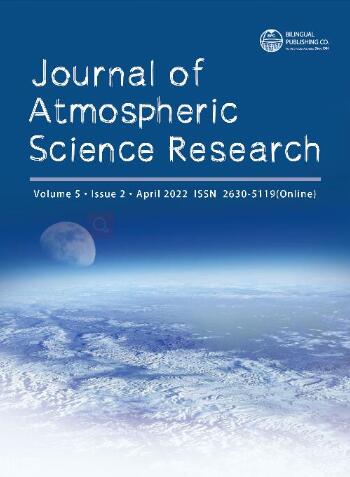-
2077
-
1496
-
1485
-
1357
-
1230
Wave Dynamics of the Average Annual Temperature Surface Air Layer New Delhi for 1931-2021
DOI:
https://doi.org/10.30564/jasr.v5i2.4639Abstract
The identification method revealed asymmetric fluctuations in the dynamics of the average annual temperature in New Delhi from 1931 to 2021, that is, for 90 years. An analysis of the wave patterns of climate until 2110 was carried out. Geotechnology of the Himalayan passage was proposed to reduce heat waves in India and China. Formulas containing four and 18 fluctuations were adopted for forecasting. Models give an increase in the heat wave from 2021, which is the fourth component. As a result, the landscape of the Himalayan mountains and the deserts of Thar and Takla Makan create a regional climate system that is original for the land of the Earth. In this system, oscillatory temperature adaptation in the future will be several times greater than the global warming rate predicted in the IPCC CMIP5 report. Between 2001 and 2019 the largest temperature increase wave maximum was observed in New Delhi at 0.65 °C in 2012-2013. In the sixth phase from 2036 to 2049, an ecological catastrophe will break out in New Delhi. According to calculations, the maximum value of the average annual temperature in New Delhi was 25.82 °C in 2017. Since then, the cooling has continued for four years, which will continue until 2028. The temperature will drop to 22.54 °C due to a change in solar activity by 3.28 °C. Then by 2044, the average annual temperature in New Delhi will increase to 31.03 °C, or the increment will be 31.03 – 22.54 = 8.49 °C. In 2035, the climate in New Delhi will become hotter compared to 2021. The increase in the heat wave is noticeable. From 1931 to 2049 there will be six half-periods of cooling and warming: 1) 23; 2) 23; 3) 20; 4) 18; 5) 15; 6) 13 years old. The most dangerous is the sixth stage. It is proposed at the fifth stage for 15 years until 2037 in northern India to the Takla Makan desert in China to build a passage up to 350 km long, 10 km-20 km wide and at least 4.5 km high.
Keywords:
New Delhi, Temperature 1931-2021, Critical wavelet, ForecastsReferences
[1] Ancient India. URL: https://history.wikireading.ru/314323 (Accessed 04/22/2022).
[2] India getting warmer, hotter: 2021 fifth warmest year since 1901, says IMD.URL: https://www.business-standard.com/article/current-affairs/india-getting-warmer-hotter-2021-fifth-warmest-year-since1901-says-imd-122011401133_1.html (Accessed 04/22/2022).
[3] Extreme heat in India. URL: https://www.drishtiias.com/daily-updates/daily-news-editorials/heat-extremes-in-india (Accessed 04/22/2022).
[4] Climate of India. URL: https://fb.ru/article/146454/klimat-indii-osobennosti-klimata-indii (Accessed 04/22/2022).
[5] Li, G.X., Zhou, G., 2016. Comparisons of time series of annual mean surface air temperature for china since the 1900s: observations, model simulations, and extended reanalysis. DOI: https://doi.org/10.1175/bams-d-16-0092.1
[6] Ding, J., Cuo, L., Zhang, Y.X., et al., 2018. Monthly and annual temperature extremes and their changes on the Tibetan Plateau and its surroundings during 1963-2015. https://www.ncbi.nlm.nih.gov/pmc/articles/PMC6082912/
[7] Chernokulsky, A. Will Europe freeze without the Gulf Stream? URL: https://zen.yandex.ru/media/nplus1/zamerznet-li-evropa-bez-golfstrima-62028bab5eaa831b62461219?&utm_campaign=dbr& (Accessed 03/13/2022). (In Russian)
[8] Zharkova, V. The solar magnet field and the terrestrial climate. URL: https://watchers.news/2018/11/11/valentina-zharkova-solar-magnet-field-and-terrestrial-climate-presentation/ (Accessed 01.03.2019).
[9] Zherebcov, G.A., Kovalenko, V.A., Molodyh, S.I., et al., 2013. Vlijanie solnechnoj aktivnosti na temperaturu troposfery i poverhnosti okeana [Influence of solar activity on tropospheric and ocean surface temperatures]. Izvestija Irkutskogo gosudarstvennogo universiteta. Serija Nauki o Zemle. 6(1), 61-79. (In Russian).
[10] Mazurkin, P.M., 2021. Quantum Biophysics of the Atmosphere: Factor Analysis of the Annual Dynamics of Maximum, Minimum and Average Temperatures from 1879 to 2017 to Hadley English Temperature Center (Hadcet). Journal of Environmental & Earth Sciences. 3(1). DOI: https://doi.org/10.30564/jees.v3i1.2489
[11] Mazurkin, P.M., Kudryashova, A.I., 2019. Quantum meteorology. International Multidisciplinary Scientific GeoConference Surveying Geology and Mining Ecology Management, SGEM. (5.1), 619-627. DOI: https://doi.org/10.5593/sgem2019/5.1/S20.077
[12] Mazurkin, P.M., Kudryashova, A.I., 2019. Urban phytometeorology: influence of the sum of temperatures on the ontogeny of drooping birch leaves. Geographical Bulletin. 4(51), 45-58. (In Russian). DOI: https://doi.org/10.17072/2079-7877-2019-4-45-58
Downloads
How to Cite
Issue
Article Type
License
Copyright © 2022 Author(s)

This is an open access article under the Creative Commons Attribution-NonCommercial 4.0 International (CC BY-NC 4.0) License.




 Peter Matveevich
Peter Matveevich





